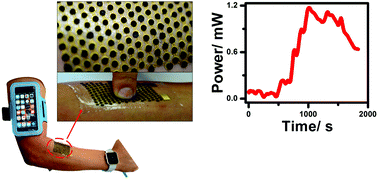Credit: Energy Environ. Sci. (2017). DOI: 10.1039/C7EE00865A
(Tech Xplore)—A team of researchers at the University of California has developed a skin patch that uses human sweat as a fuel source to power an external device. In their paper published in the journal Energy & Environmental Science, the team describes how they built their patch and how well it works.
Scientists and engineers are convinced that consumers want easy-to-wear consumer products—health monitors that are built into clothes, for example, or that adhere to the skin. To that end, teams around the world have been developing bendable products with associated batteries, or better still, devices that do not need batteries because they get a constant stream of power from the person wearing them. In this new effort, the researchers have found a way to harness human sweat as an energy source and report that the device they built was able to power a Bluetooth transmitter.
Sweat can be used as an energy source because it contains lactate, which produces energy when it oxidizes with lactate oxidase. The researchers applied the enzyme to their anode, which was made using porous carbon nanotube-naphthoquinone structures. The team created electrodes using what they describe as "gold islands," which were joined using stretchable material connected to polymer bases. The cathode was made using porous carbon nanotube-silver oxide structures. The result was a tiny patch just a few centimeters wide, but which was able to generate enough power to run a small Bluetooth device (and an LED) when worn by a person running on a treadmill. It produced 0.5 V of power with a density of approximately 1.2 mW cm–2 at 0.2 V. Because sweat was continually produced, the device needed no batteries.
Credit: Energy Environ. Sci. (2017). DOI: 10.1039/C7EE00865A
The researchers believe their device could prove useful as a means for powering health monitoring devices such as new kinds of glucose monitoring machines that measure the amount of glucose in sweat. It could also be used to measure other substances in sweat—lactate levels, for example, can give an indication of how well muscles are working. It could also be used to power a Bluetooth device that sends health information to an external source for analysis.
Credit: Energy Environ. Sci. (2017). DOI: 10.1039/C7EE00865A
More information: Amay J. Bandodkar et al. Soft, stretchable, high power density electronic skin-based biofuel cells for scavenging energy from human sweat, Energy Environ. Sci. (2017). DOI: 10.1039/C7EE00865A
Abstract
This article describes the fabrication, characterization, and real-life application of a soft, stretchable electronic-skin-based biofuel cell (E-BFC) that exhibits an open circuit voltage of 0.5 V and a power density of nearly 1.2 mW cm−2 at 0.2 V, representing the highest power density recorded by a wearable biofuel cell to date. High power density is achieved via a unique combination of lithographically-patterned stretchable electronic framework together with screen-printed, densely-packed three-dimensional carbon-nanotube-based bioanode and cathode array arranged in a stretchable "island-bridge" configuration. The E-BFC maintains its performance even under repeated strains of 50%, and is stable for two days. When applied directly to the skin of human subjects, the E-BFC generates ∼1 mW during exercise. The E-BFC is able to power conventional electronic devices, such as a light emitting diode and a Bluetooth Low Energy (BLE) radio. This is the first example of powering a BLE radio by a wearable biofuel cell. Successful generation of high power density under practical conditions and powering of conventional energy-intense electronic devices represents a major step forward in the field of soft, stretchable, wearable energy harvesting devices.
Journal information: Energy & Environmental Science
© 2017 Tech Xplore
























